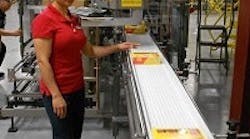Single-serve packages of cracker sandwiches pass under a vision system en route to delta-arm robots for placement in cartons. The equipment replaces multiple machines, including obsolete pick-and-place robots.
Technology’s impact on bakery production is reflected in higher throughputs, increased efficiencies and superior outcomes. To realize technology’s full potential, however, requires human change, either in the goals of management or the expectations of staff.
An example of the former is found in vacuum cooling. First, it was simple salad greens that were subjected to vacuum cooling as an alternative to shipping 1,000 lbs. of ice per pallet from the West Coast to the Northeast, demonstrating the solid economics of the technology. Vacuum cooling of baked goods, on the other hand, is a rarity in North America, although executives in Europe and elsewhere who have crunched the numbers are gravitating to the technology.
Ambient cooling in large spiral coolers is the norm for commodities like buns and rolls, with blast freezing sometimes used for higher-priced goods. Time, space and mechanical refrigeration have costs, and some bakers are switching to vacuum to speed throughput, lower labor costs and reduce energy inputs.
About 30 bakeries worldwide are using a system from Aston Foods AG in Steinhausen, Switzerland, including two continuous systems in Turkey and Saudi Arabia, according to CEO Christian Vetterle. No refrigerants are involved in the cooler: The pressure gradient is managed by controls that adjust the vacuum to anywhere from 10 to 500 millibars (0.145-7.252 psi), depending upon how much steam is generated by the product load.
Not only is the final set-point temperature reached faster, “bake time itself also is reduced,” Vetterle explained in an e-mail exchange. “In a traditional baking process, the definition and final stabilization of the crumb-matrix happens during the last phase of baking,” when starch and proteins gelatinize. “This process can take place during the first phase of vacuum cooling as long as the temperature of the crumb is between 60-95°C.” Starch retrogradation is much slower, which retards the drying out of finished goods.
Capitalizing the system gives many executives pause, he allows, although companies as far flung as Australia and South America have crunched the numbers and converted to vacuum cooling. All had to first make a financial case for the investment, says Vetterle. Some realized substantial sales increases, as a result of both compressed production time and positive consumer responses to better-tasting baked goods.
Engaged associates
Securing capital is a challenge that stops many technology upgrades cold, but that proved to be one of the easier elements in a bakery upgrade at the Charlotte, N.C., manufacturing site of Snyder’s-Lance Inc. The facility is in the final stages of a $75 million upgrade that began last year and was put in motion in 2008 when new leadership came on board.
Some of the improvements were needed to meet higher sanitary standards set by the Food Safety Modernization Act, but managers felt equipment upgrades would not yield expected improvements unless the culture of the plant first was changed.
“It wasn’t about the equipment,” emphasizes Gregg Flickinger, vice president-manufacturing and corporate engineering, “it was about building the work system around the equipment.” Change management began with kaizen events, standard work development and strategic autonomous maintenance initiatives designed to foster bottom-up change.
Glong Pang monitors the infeed to a casepacker being commissioned on a new line at the Snyder’s-Lance factory in Charlotte, N.C. When the high-performance work team concept was implemented, she seized the opportunity to move from an operator job to a maintenance position.
Engaged associates participating in work teams address persistent needs such as waste reduction, worker safety, product quality and green initiatives. “An unintended consequence of the green team’s recycling focus has been continued development of 5S,” says Flickinger. 5S is an operational methodology that asks employs to Sort (or take out everything needed for a job), Set (group like items together), Shine (clean everything up), Standardize (make sure everything has a place) and Sustain (audit the process and keep it going). That has been important not only in improving housekeeping and sanitary cleanup but also the removal of redundant and obsolete equipment, “adding intrinsic value,” he adds.
With 1.25 million sq. ft. under roof, the Charlotte facility is actually two plants in one. The bakery, where most of the approximately 1,000 employees work, was built in 1962. The adjoining potato-chip plant came along 12 years later, but it was somewhat starved of reinvestment capital in recent decades, resulting in a loss of morale.
That began to change two years ago with Operation Metamorphosis, “a springboard for a lot of work on training, communication and team building to get people engaged and change the way we run our business and interact with our associates,” according to Arbie Thomas, plant manager. A dozen frying kettles that arrived in the 1990s from a shuttered Eagle snacks operation were replaced with four kettles that produce higher volumes and more consistent product.
Inconsistent application of seasonings once generated the highest frequency of calls to Snyder’s-Lance’s consumer hot line, but compliments now surpass complaints, which have fallen by half. Assistant manager Andy Blackburn credits the infeeds to the seasoning machines for the improvement: Instead of slide gates that regulated the flow, the system utilizes a proportional gate from Heat and Control Inc., Hayward, Calif.
The gate “acts like a valve” for continuous infeed, according to Blake Svejkovsky, a Heat and Control engineer. Instead of a gate, the conveying drum rotates to expose narrower and wider areas on an oval-shaped opening to consistently dispense chips into the seasoner. Cross contamination of seasonings is less likely than with older systems, which were located closer to the fryers, he says, and changeovers are quicker on the more compact units.
A graduate of West Point, Blackburn is among the junior military officers recruited for the Charlotte operation. He exemplifies the “servant leader” model being deployed for plant management. The goal is to “create candid conversations” between associates and managers, says Jeremy Bowen, director-manufacturing, in which critical feedback and ideas for corrective changes are central to the continuous improvement effort.
As in the bakery, epoxy coatings on walls and ceilings and continuous flooring to replace brick have brought the chip plant up to contemporary sanitation standards.
The bakery pays the big bills, and most of the announced $75 million capital infusion was plowed into that section of the facility. A big chunk went to packaging machinery for what’s known as the Crayola line, a reference to a new box design reminiscent of the crayon container but which also could refer to the rainbow pallets that now can be assembled.
Cases from multiple lines converge in “perpetual merge” lanes feeding robotic palletizers, where mixed loads can be assembled. “Everybody you sell to wants customization,” says Flickinger. With the new technology, Snyder’s-Lance can deliver it.
The plant update also underscores the evolution of food automation. The old line’s conveyors snaked over and back through the packaging area to orient products to machines with limited capabilities. An early generation robotic pick-and-place machine exemplified the problem: Occupying a footprint of about 50 sq. ft., its two axes of motion locked Lance into a single tray pack.
That machine and others are replaced by ABB Flex-Pickers that can fill any number of tray configurations. The new equipment is considerably more compact, opening up the work area and fostering the kind of staff interaction and collaboration leadership is nurturing.
Advanced automation enables productivity improvements, but people drive it. Snyder’s-Lance is shooting for best-in-class production status, and that requires retooling of both the people and the machinery. The mission is summarized in signage that reads, “Our house, our future.”
Whether an equipment upgrade or new technology is being considered, plant improvements are unlikely to have the hoped-for effect unless they are accompanied by a fresh approach by both management and staff. People are the X factor in bakery automation, and how they interact with system improvements determines how much impact those changes will have.


